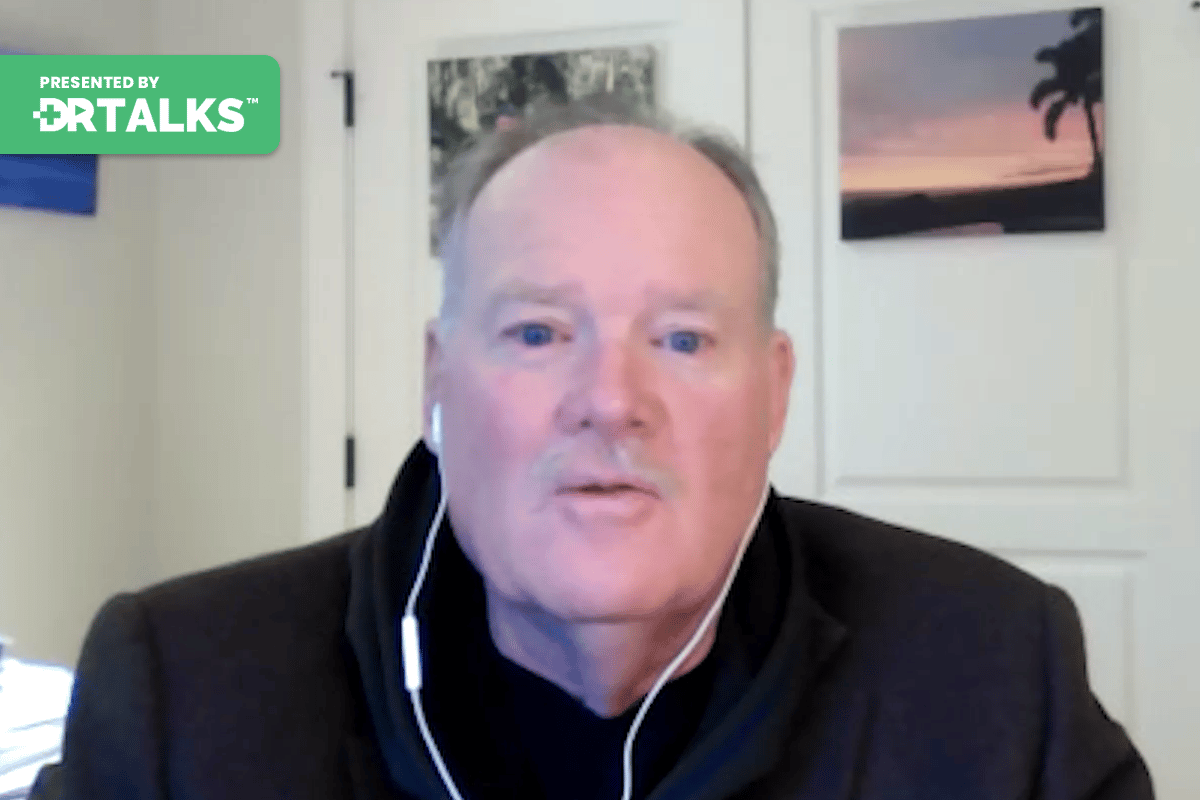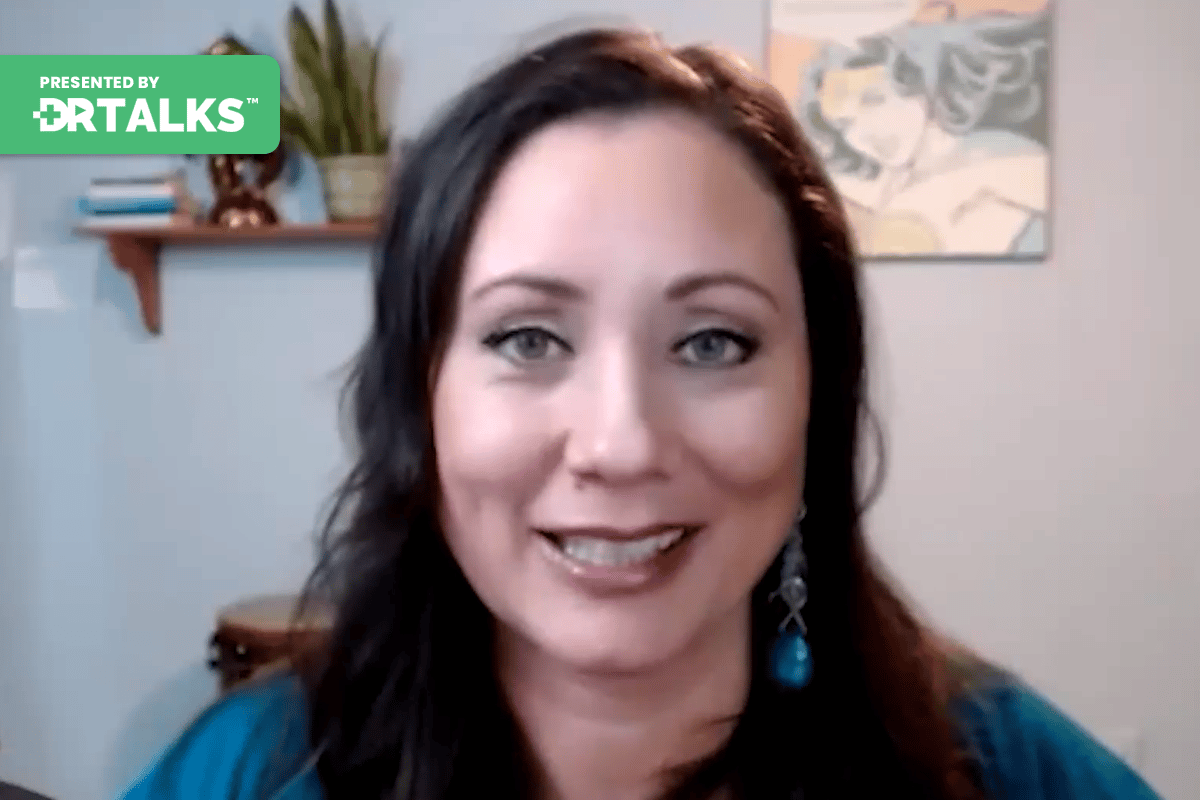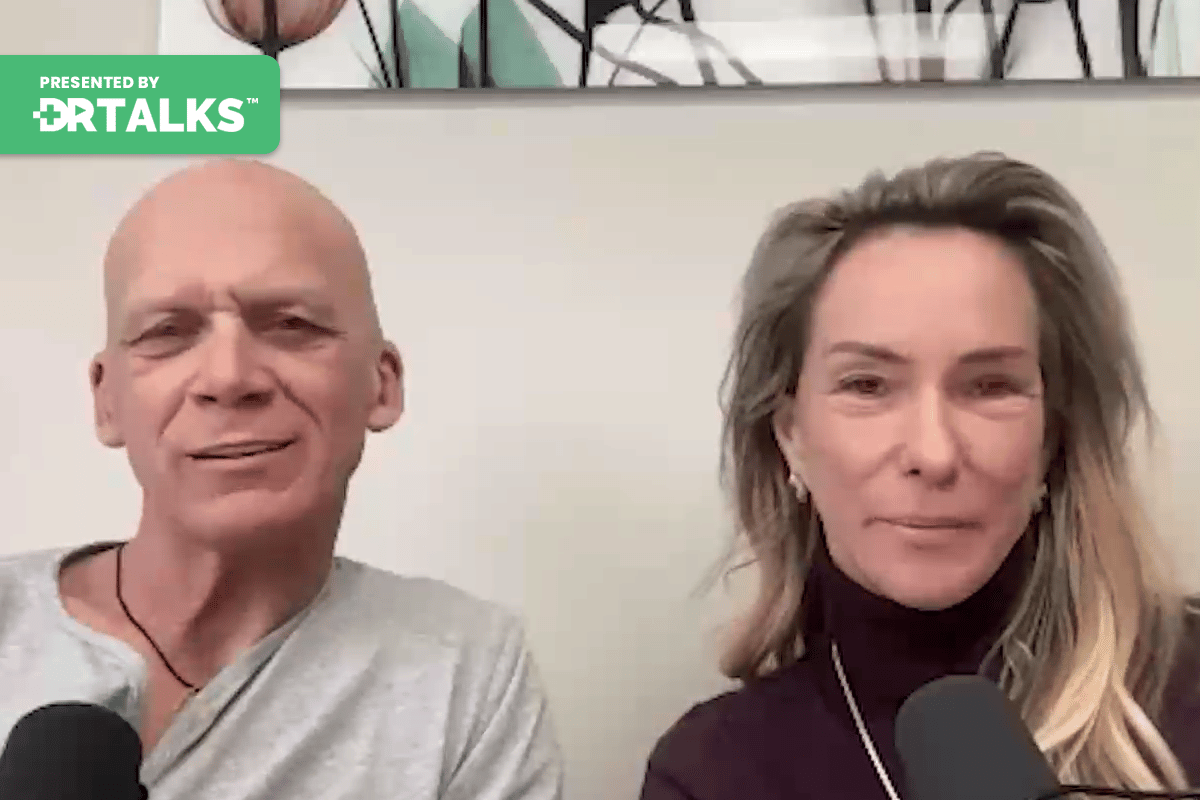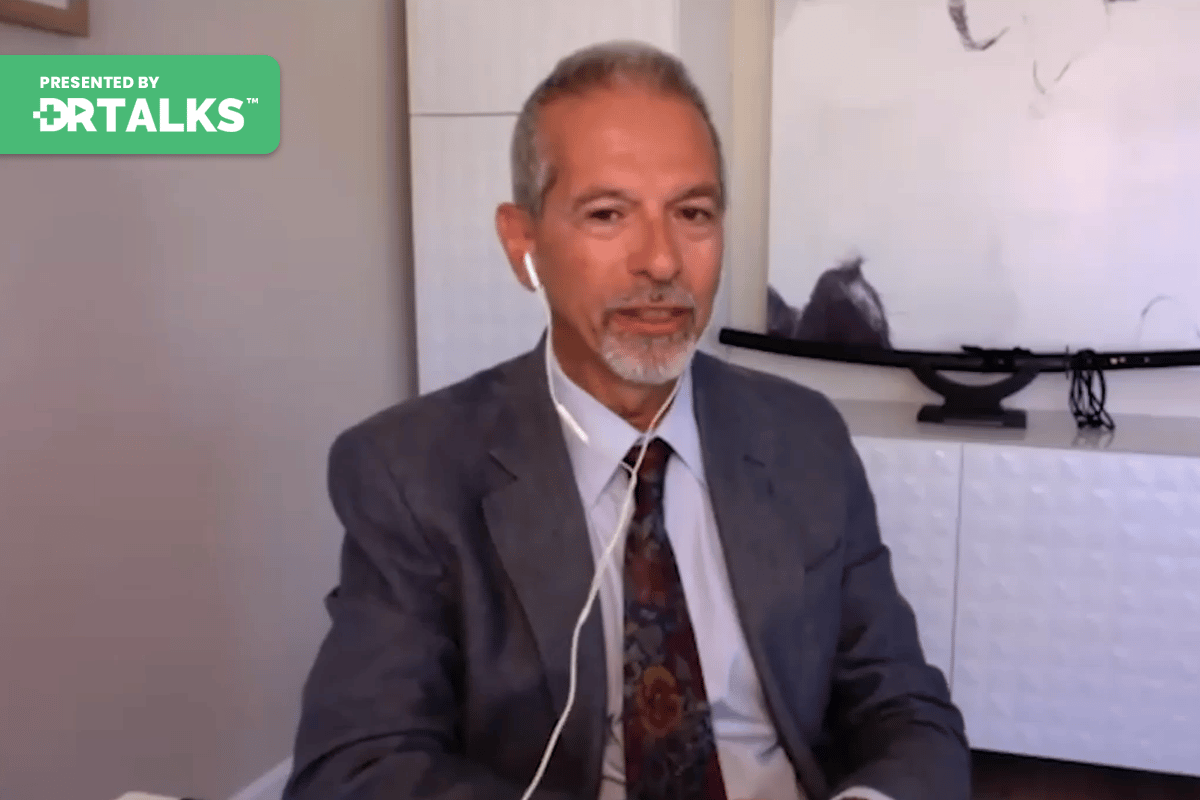Join the discussion below

Dr. Diane Mueller is the founder of My Libido Doc, an online community dedicated to helping women reclaim their desire. My Libido Doc provides education, community and health care services for women. Alongside her double doctorate in Naturopathic Medicine and Acupuncture, Dr. Diane extensively researches libido, pleasure and women's health... Read More
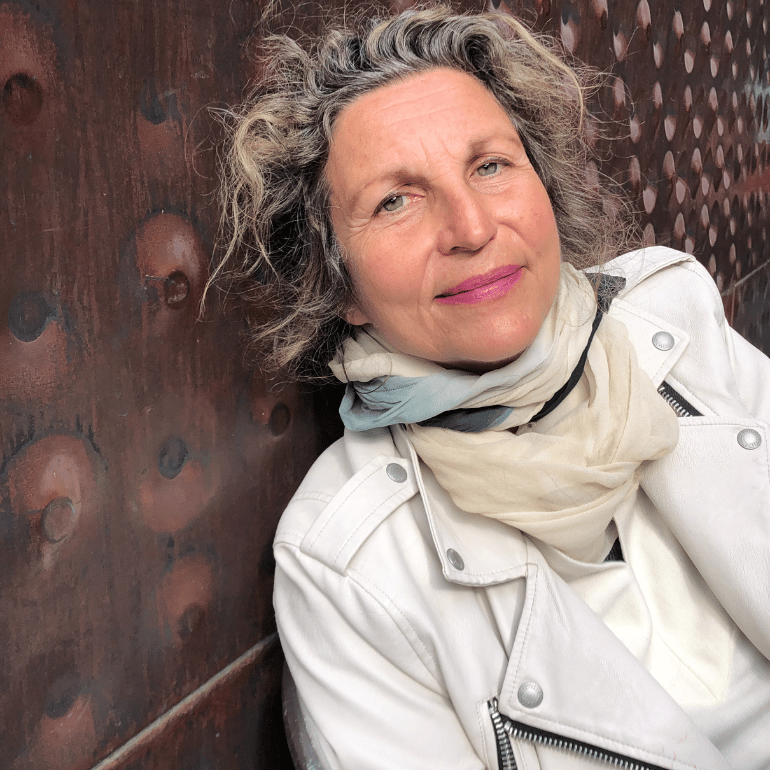
Gina Bria is an anthropologist and founder of the Hydration Foundation, recognized as a leading resource for hydration science and education. Named a Real World Scholar, she produced the first International Hydration Solution Summit and the TEDx talk: How to Grow Water: It’s not Only Blue: it’s Green. Bria is... Read More
- Hydration runs every system in our bodies, why is no one mentioning it’s profound role in mental health
- What is full hydration of our tissues, especially our brain
- What is the role of hydration in our microbiome
- What’s a better way to hydrate without guzzling all that water
- How can we hydrate our microbes? What does fiber-rich foods have to do with hydrating our microbes
Diane Mueller, ND, DAOM, LAc
Hey everybody, Dr. Diane Mueller here again. Welcome back to another episode on Microbes and Mental Health. I am thrilled to invite to the summit Gina Bria, the founder, the founder of Hydration Foundation. Thank you so much for being with us today.
Gina Bria
I’m really excited about this topic. Thank you Dr. Diane for allowing us to bring better information on hydration and its role in mental health and our microbes. I’m very excited about this topic.
Diane Mueller, ND, DAOM, LAc
We’re gonna have a great time today. And let’s just kick it off with telling people how you got into this work and into this world of just studying and researching and educating so many people on water. Tell us about it.
Gina Bria
Oh, well, I’m coming in from such an unusual angle because I’m at actually a cultural anthropologist and my research was looking at how desert communities right around the globe. So, I went to all the deserts around the globe either through ethnographic research and writing pre industrial strategies for hydration, and looking at how they could hydrate and be better hydrated than we were without eight glasses of water a day. Like, I mean, everyone knows that right? You’re supposed to guzzle eight glasses a day. And in my research, what I discovered I was that desert communities use plants, the water locked in plants to get their hydration. And I was fascinated by this. So, if you think cactus of course, or aloe right, tubers under the ground. They were all getting there as if the plants were faucets, do you love that?
Diane Mueller, ND, DAOM, LAc
I love it.
Gina Bria
And it was just incredibly extraordinary to me because I was like, well why aren’t we getting our hydration from plant? Plant water locked in plants? Because that water inside plants is it transformed water? It’s not liquid anymore. It’s now tipped into a liquid crystalline state by virtue of its exposure to the sunlight and to the minerals in the soil. So I’m going to say something very bold here and let’s we’ll follow up so I can really, I hope delight your audience with new ways to hydrate. But an apple is actually more hydrating than a bottle of water. And that is because the water inside all that juice is in a different state. It’s a liquid crystalline state of water. And the fiber in the apple allows the slows down the whole process of hydration and it allows the body to, the fiber allows the body to actually absorb the water and then drip irrigate our system over time. So it’s both an absorption mechanism and a time release mechanism. Not to mention that nature has packaged all of that with its nutrients from the apple and the electrolytes from the apple. All extremely sophisticated system. So our water bottles should really be fruits and vegetables.
Diane Mueller, ND, DAOM, LAc
So what you’re saying, it sounds like is not when it comes to hydration, it’s not about what we consume, it’s about what we absorb, correct.
Gina Bria
It’s absolutely what we absorb when we drink from our water bottles all day long. And we’re actually can flash flood our system and as little as 10 minutes and it wipes out the very electrolytes that are allowing this exchange in the body for water to come in to be absorbed to be time released. And to do the work, the electrical work, the electrical work that water is supposed to do, not just the moistening work. So this relationship of now we can shift the conversation to hydration and mental health. So I will want to say that first brain function runs on electricity 80% versus chemical reactions which is only 20%.
And yet we’re guiding all our interventions for our brain health and high brain function To the chemical reactions and missing the vast beautiful impact that the electrical function and therefore hydration hydration alone. So I have this figure about the elect 80% electricity from 20% from Dr. Sara Vananrooy. She’s an MD, a functional physician. And the Beatrice who spoke on our hydration solution summit, which is a public service we have for anybody to go to our website. I’m sure you’ll put the link in there. But she was one of our speakers there. It’s still up on my website. She is so committed as a psychiatrist to hydration that she won’t even do an intake interview with you without hydrating first And then tracking your hydration. So we Dr. Vananrooy and I were both aware of the clinical studies showing that even a 2% decline in hydration leads to measurable cognitive loss including executive function. So this is extremely important information in the mental health field for helping people realize that our cell function and our brain function depends. It’s all water based. It’s hydration based. In fact the brain is just one of the systems in our entire system, including our gut and microbes in there and we’ll get a chance to talk about that too. Which is a hydration based. So water is your fuel, right? It’s your moisten material. It’s a material, it’s a fuel but it’s also how information exchange happens in our system and when you think about mental health and the kind of electrical storms that we’re facing inside our brains. If you want to call those difficult path pathways of thought to think about them more as electrical storms and how we dampen those down, then we can see why I spend all my time talking about hydration and why it’s so essential.
Diane Mueller, ND, DAOM, LAc
Yeah, I love it. And it’s a I’m so glad you’re talking to us during the summit because we’re there’s so many things that we’re talking about around like this advanced lab test or that advanced lab tests and all that’s wonderful, right? We got to do all those things and sometimes I find when I talk to people we get so excited about all these like you know wild test and all these things we have to do. And we haven’t even talked about the most fundamental foundational thing, which is so impactful, which is, you know what we’re talking about here. So let’s take a step back to something you said earlier about absorption. Can you tell us a little bit about like the process of absorption and how the absorption process of water works in the body?
Gina Bria
Yes. So the work that I did with the desert communities, right? And I’m finding that the plants that they use all had this commonality, they were like alot they were jelly like plants, right? And I kept going well, I don’t really understand the mechanism, but I see the result that they are getting much better hydrated than we are by ingesting plants that have this gel gel like quality. So I’m like, I’m calling all my colleagues like, what? What the heck is that gel stuff? What? Like, what is that? And it wasn’t until I made that fateful phone call to biomechanical engineer at the University of Washington. His name is Gerald Pollack. He is a bench scientist. He studies the basics of cells and cell structure.
And he said, oh that’s that’s concentrated water. It’s it’s it’s it’s the fourth phase of water. It’s beyond vapor liquid and ice. There is a phase where it’s a gel like form of water And it’s like almost like a plasma and it can be as thin as just this liquid crystalline stage which is just like 10% more viscous than a glass of water. In fact, if you have a glass of water that’s structured you can taste that it’s silky, you know immediately it’s not it doesn’t it just has a silk and velvet equality because the the water has started the transition into this other phase of water and he said oh don’t worry about it. You know, it isn’t just desert plants, it’s all plants that have this in their cellular structure, in their cellular structure and O. P. S. By the way, that’s what all your cells are made out of. And I’m like, what are you telling me that our bodies are made of different water than liquid, that the water inside ourselves and our interstitial. And he’s like, oh yeah, all tissues made out of this gel like water. And I’m like okay, what do you know about hydration? He said, well I don’t know a thing about hydration and I said well we better start working together because you do just blew out the whole thing about how hydration gets into the body and it goes, we ingested as liquid or we think that’s the only way we’re going to get hydrated.
And everybody tells you, the only way you’re gonna get more hydrated is to drink more liquid. The absorption is actually involved in this transfer of switching water from a liquid state into a jelly like or plasma state and there are tons of ways for that to happen because mother nature is very committed to this process because once water switches into this gel like state, that is when it can conduct information at the highest level. So then it’s an electromagnetic field when it’s in the liquid state, it can do it a little bit when it gets into the gel state, it’s crazy. It’s called a superconductor. And the way that happens is first of all, the fibers and foods and that whole absorption through eating big clue second is exposure to sunlight. So when you’re out in the sun, the sun is hitting your skin and your water, the water molecules inside your body. And it’s switching it into that state.
Diane Mueller, ND, DAOM, LAc
So fascinating.
Gina Bria
This is incredible. Right? It’s like, okay, wait, wait, now, wait. It gets even better because not only do exposure to sunlight eating a healthy diet full of plants that are full of this food, but also movement generates this same electric, same physio electric charge, which then changes the water into this amazing state. So we’re talking levels of hydration strategies that we haven’t got on the table that are urgent. So, you can see what’s what, why we have to have a much bigger conversation about how to get hydrated than just guzzling in many cases often neutral or bad water.
Diane Mueller, ND, DAOM, LAc
So the question I have with all of this, This is super fascinating Is like this timing matter, right? So, for example, if somebody is drinking a glass of water, which I understand is far from that gel like state and then they go into the sunlight, right? Where we’re saying that’s helping with that conversion. Is there a timing? Is it more about like when something is consumed like drinking glass compared to the sun? Or does that not matter? Because water is more about water flowing in our inter cellular space or what does that, does that influence things?
Gina Bria
Not really. What we want to do is just start stacking these strategies in whatever way we can. So, if I can just speak from the anthropology point of view again and say that we as moderns in our modern lifestyle are all the 100% of us are dehydrated. We are not operating on our optimal hydration. And because I’ve now helped you sort of set the stage to see we are water bodies were living on land, but our entire structure is a water-based water made set of tissues. And when people say, Oh, you know, we’re 99% water were 70, water. All these different statistics, they throw what they’re not thinking about is that every single cell is a packet of gel water, it’s a plasma packet with a membrane, like a little ziploc bag, right? You know, we’re made up of millions of these little cell structures and all of those are the buoyancy of them.
The function of them depends on them being well hydrated. So helping us say I truly am a body of water and now I’ve got to figure out how to move through my day, supporting myself as a water being. This is the first big message I want your audience to hear once they have that knowledge that they are a a fluid dynamic fluid being, there’s in, there’s out there’s input and there’s output. So this is a whole river system that we’re living. And we start thinking about all the ways that we can support ourselves as fishes in the stream of our own water. Then we have, you know, we’ve helped shift the conversation to go, okay, now I get why hydration and mental health have everything to do with each other.
This isn’t a cute little sidebar like, oh yeah, don’t forget to drink holy cow! No, we’ve got a whole other context now and now I can shift as an anthropologist looking at our culture and recognizing that the hits on our hydration by virtue of our lifestyle are happening moment to moment. And I don’t want to scare you. I just want to get you in the context. So of course we’re eating dehydrating foods, right?
So that pizza, you know, we, I just want to help you to think, okay, if I’m having the pizza, I need to have a salad with that or an apple, go finish it with an apple or go have a nice big glass of water with a pinch of salt in it, which electrifies the water, right? It’s that’s the mineral, that will be your trick for whenever you are drinking. But now we know that immobility has a huge hit on our function as a flow system because when we’re not moving, we’re not moving those hydration into our tissues, were not moving the system through. So, of course we’re, what do we do? We sit at our desks all day. We lay around and watch netflix. We commute to work in cars, airplanes. All of these are dehydrating environments were inside away from that sun. The amount of time we spend outside as modern people is shocking. We do not get out and we actually need the sun to drive the information about the water in our bodies. And ps all our microbes are microbes are tuned to the sun. So when we’re inside, they’re missing the signaling from the sun. You only need to go out and look at the morning sun or get out a little bit during the day and all your microbes are like, okay, here we are on the clock. Okay, that’s our job. Now, we now know the sequence of what we’re supposed to be doing if you don’t get that sunlight, not only are you affecting the water in your cells and they don’t have the signaling you need, you’re now affecting the signaling that your microbes are doing.
Diane Mueller, ND, DAOM, LAc
And we’re talking good microbes here, right?
Gina Bria
We’re talking about the, you know the beautiful the ocean inside of us where there’s a whole ocean in their full of little creatures. They’re always looking around very happily and they want to work together. So things like pharmaceuticals are deeply dehydrating. You know, our foods are dehydrating are in mobility, our electrical devices. So for example, I hate to tell you this, but your cell phone is dehydrating. Okay, I just wanted you to know that. So now we can start having the strategies for how we’re gonna move through our day, aware of those things and then compensating and then optimizing our hydration so that our mood, our capacities, our perceptions, our ability to receive all of this extraordinary life coming in is reshaped by those water molecules organized together.
Diane Mueller, ND, DAOM, LAc
Okay. Yeah. I think a lot of people listening to this are gonna be shocked. You know, it’s a revolutionary ways way of thinking that drinking more water is not necessarily going to be the thing to hydrate us and even what you’re saying around food around certain food sounds like a lot of standard American diet types of foods are doing the opposite of, you know, a lot of times, I think we think of these things as like neutral hydration and not negative hydration, like you’re talking about. So now that we have probably woken some people up, including myself to how water works and this gel like thing is a very new concept, I think for a lot of us, what do we do about it?
Gina Bria
Well, you live a luscious life.
Diane Mueller, ND, DAOM, LAc
I love that.
Gina Bria
Yeah, juicy, luscious life and that involves your awareness that so when you wake up in the morning, let’s just go through a day. So it just helps really set the calendar for your life. You know you get up in the morning and you are going to want to rehydrate after you’ve slept and there’s two important reasons, one, the moistening has gone down. But secondly, during the night, your brain and again, this is all about mental health. Your brain has done the entire sanitation work through the night. And this is a really extraordinary new work.
We’re finding about the glen fat IQ system and the first big mystery that happened when people started looking into the brain and the brain cells. They saw that during the, during sleep, all your brain cells start to shrink and they were like, oh no, that’s what’s going on, that’s terrible, what’s going on, What they were doing is creating a pathway for hydration to flow through there, squeezing out waste and then the hydration comes through its nighttime sanitation, right? It comes through washes out all your ways. So really important to have hydration for sleep, because if you don’t have enough hydration for sleep that waste stays in your brain. So we’ll tell you how to deal with that at the end of the day. So you’ll have dehydrated for sleeping. But when you first get up, the first thing you need to do is give your system a nice wash. So you’re washing out your body can now get rid of the waste that it’s accumulated during the night, which is its job.
Diane Mueller, ND, DAOM, LAc
So you’re going to do that with water, correct with
Gina Bria
It’s great to go get yourself and you have to manage these things according to what is a pleasure to you because if you tell someone you’re supposed to go drink 16 oz of water first thing in morning, they’re like, Oh my God, I just want my coffee. Well, I have my coffee, I have my coffee in the morning. Sometimes I’ll have it with mushroom powder. Sometimes I’ll have it with butter. Sometimes I have it with cocoa. Sometimes I’m having fun. But I do find somewhere in my morning fairly soon too, when I get up to get myself a nice glass of warm water because the body doesn’t have to do the work of heating it up and I always put a pinch of salt in it. So this, we’re talking now these quality salts, sea salts, rock salt salts, that are really valuable for starting that electrical chain in the water and making that water more hydrating. So you don’t have to drink 16 ounces and blast your system if you put a little salt in that water, what you’ve really done think about it Dr. Diane, you’ve created a very mild saline solution, which is what they would do if they had to send you to the hospital for rehydration incident, right? If you were dehydrated it, put you on an I. V. Bag bag with sailing in it. So I do my morning routine. I love my coffee first thing in the morning, but then I will find a way to just park in my morning. Beautiful glass of warm water with salt in it. Sometimes I add lemon, sometimes I add a cap full of apple cider vinegar, sometimes it’s just teas, teas are very potent and and many longevity traditions use teas to hydrate and it’s because the plant material in the tees creates this also creates a gel reaction because plants have electricity in them too and they’re talking to the water and they get going and they get in a big conversation. So once you’ve had, yeah, well yes, I if you want to stop and ask me think I was going to go through the day but we can keep, we can break it up too. So
Diane Mueller, ND, DAOM, LAc
Yeah, let me just ask you a couple questions here because there are pertinent to this is just because I know these might be coming up for people, one is with the salt and you mentioned you can use different types of salt and we have obviously our most classic Himalayan salt which I, the pink salt that most people are familiar with. That salt comes from so many areas of the world and it’s so many colors. Do you find that there’s benefit from a hydrating standpoint for people to actually be collecting salt from around the world and mixing it definitely.
Gina Bria
It’s fun. I mean I have black salt with volcanic ash in it. Don’t tell me that that isn’t valuable for my body in some way you know and everybody has to experiment because this is your country, your country does it your way. But yes I do and I will make a couple of salt recommendations that I think help answer some of the questions because people are worried about microplastics and you know microplastics in the water and salt processing. We’re going to do the best we can. But I think that Redmond brand, it’s a salt from a dried seabed out in Utah that’s an excellent salt and I love the way it mixes very easy with the water and I just love it.
I have no investment in their company. I’m just I think it’s a good brand and colima salt which is a salt from the yucatan also, they are excellent and in terms of the micro prep plastic pollution Again if your water level is well hydrated, your body is going to take those and move them out as waste material. But it can’t do it without the salt. So we can’t not drink this all because of the microplastics which then means we rehydrated which means we can’t get the waste out. Which you know it’s like this cycle you’re going to start upping your hydration in such a way that it will wash out. This is what water why we’re made the way we are. It will wash out the contaminants.
Diane Mueller, ND, DAOM, LAc
Perfect. And then my other question for you before we continue on with the recommendations from wake up to bedtime is when it comes to the herbal tea. When it comes to tea you’re talking about a lot of herbs do you have, even if it’s a small diuretic component? So do you feel like if an herb has a diuretic component, Do you feel like the benefit of hydrating from a T. Kind of outweighs that diuretic component?
Gina Bria
Yes I do because they’re two different systems so they don’t immediately cross over you’re still getting a much better hydration system up and running. And what you find with these teas and so forth is as you start to use them, your body will make the adjustment and you don’t end up peeing as much and then we’ll talk a little bit more about the through the day why my plant strategy keeps water well absorbed. Right? So I did forget to mention that. When I first wake up, I start wiggling in bed, I just, I just either roll my shoulders or I roll back and forth in bed. I roll my head, all of those is to just start the flow moving. So even before I get out of bed I wiggle a little bit and I get motion into my day.
Then I go have my coffee, I go have a nice glass of water somewhere in there and then my eating routine. It depends on whether I’m practicing intermittent fasting or whether I’m you know, taking a break from might be a post party day where I’ve had some fun the day before. So I’m always strategizing, okay, what can I bring into my food channel today that will really continue this up leveling of my hydration. So I have specific foods that I’m always kind of shooting for somewhere in my day. And one of those really important foods besides things like cucumbers and celery and arugula and watercress, please.
Watercress is a huge cruciferous. It’s got great value. Apples, berries, you know, melons, all of these are going to be part of my day as I move through my day if I’m, if I’m going for a luncheon and somebody’s giving me a grilled cheese sandwich, I’m definitely gonna run out and compensate for that if I can’t get a cucumber on my plate from the kitchen staff, you know, it’s like just, I’m always thinking, how do I compensate? So the foods are really important. One food I really think is missing from our hydration strategy that doesn’t get talked about enough is mushrooms. And the trick with mushrooms is go buy a powdered brand. It has five or six different mushrooms mixed in with it and dump it in your morning smoothie, put it in the soup. You’re making, throw it in your salad dressings that you’re shaking somewhere, get mushrooms in your life because mushrooms are incredibly electrical. They carry tremendous soil information, right? They are an archive that wants to give you all of this information right into your system. We’re not eating enough of those in our life to counterpoint the kinds of contaminants and the kinds of radiation that we’re exposed to through E. M. S. And stuff today. So mushrooms are very beautiful, powerful.
Diane Mueller, ND, DAOM, LAc
Perfect. So we’re going to win. And we wake up bringing, yeah, bring in our water that has salt in it and make sure that we’re not sacrificing our coffee, bringing mushrooms and watercress and all these other great foods. What else are we doing throughout the day?
Gina Bria
Yes. So then movement and wiggling. I continue the whole wiggle process. So I don’t have my cell phone with me. But normally if I’m on a phone call, I’m nodding all the time, people think I’m very positive, but really what I’m doing is I’m creating a flush, a synovial flush all the way down my spinal canal just by dropping my chin to my chest. This is an incredibly powerful movement. I practice it all the time. I am using my the weight of my, my head and the movement of my body to shove water through my system and push out waste. This is incredibly important. And it isn’t a big deal. It’s not like I have to go run a marathon, it’s just little wiggles throughout the day. And you know, if you flex your fingers and your whole, all those, these are all little water canals, right? And you’re moving all that material through it.
You’re just aware of that if you’re sitting in a movement in a, in a meeting, you’re on zoom. When I’m on zoom, I was tapping my foot, are doing a fidget of some kind. And I just find not only is it increasing my hydration, because I know that movement creates, generates electrical function that informs the water. The water gets into a better state. And it becomes a whole lifestyle to just be a fluid, vibrant person that’s really important. So wiggling through, continuing to wiggle through the day. And then of course I try to have as many as my phone conversations outside as I can. And the reason outside is so foundational is that sunlight is the great archive of all information and life and energy and even walking in the forest, vast amounts of information are coming from the trees, the pollens, the birds, you know that that bird songs is a frequency that helps plants grow. We have new science on that. Okay, come on people.
Diane Mueller, ND, DAOM, LAc
That is so exciting.
Gina Bria
Bird songs helps plants grow. I love this system
Diane Mueller, ND, DAOM, LAc
Very cool.
Gina Bria
So and then when I’ve got my walk in, which I cannot miss because I know it runs my system for the day. I also use Dr. Diane. I listened to a lot of music while I’m working because I know the sound frequencies just like those birds, the sound frequencies are changing the electromagnetic fields in my water system and I am, I know this is gonna sound crazy but we’re blasting open completely new ways of thinking, right listening to music is hydrating, it makes yourselves more buoyant and more electrically charged and better to coherently communicate back and forth to each other. So kind of setting anything that has a low frequency beat. So anything, it doesn’t matter if it’s, it’s not a genre, it’s percussive, do all of that.
And of course this aligns with healthy cultures who spend a lot of time drumming and dancing and walking. All, even walking is a form of percussion. So it’s a system that always working together beautifully but adding now sound baths, adding music, I listen to Pandora and Spotify, I’m always trying to bring gorgeous music in. Even when I lay down at night, I’ll listen to some of these free youtube, fall asleep to 4 32 frequency, go find something, you know, you are, you resonate at a certain level. So you’re going to find the one that, oh, I like this or that one’s annoying. No, but you know, you’ll find it. But if you didn’t know to look for it, you wouldn’t have found it.
Diane Mueller, ND, DAOM, LAc
And I like your connection that you mentioned earlier. It’s a pleasure when you’re talking about like coffee and all that. Talk about that a lot in my work around like pleasure helps us stay present. Pleasure helps us stay motivated. So what I hear in this and like even the music is like, get that low frequency, you know, you need that. But other than that just find something that’s pleasurable for you, right?
Gina Bria
Absolutely. And then so I’m listening to music, I’m doing my work. I’m on the phone with people with all of it. All of them turn out to be hydration, uplift ear’s just even though it looks like work, I’m nodding a lot, even though it looks like I’m not an exercise lock. I’m bathing in the glory of nature that wants to love and support us because we’re part of her too. You know, she wants to uplift us and then towards the end of the day, I take rest extremely seriously. So we have systems where we need stimulation and then we need integration and rest. So finding ways to get to bed in a beautiful way. We all struggle with scrolling on our phones. It’s designed to addict us, we just can’t help ourselves. It’s actually an electromagnetic field. So when you’re on yourself that is you have to break the magnetism of those scrolls, it’s all set up to capture you. And if you can just turn that down and I especially like to entice myself out of the scroll. Doom the doom scrolling that I do with a treat at the end of the day. And for me that’s chia pudding. Why I love chia pudding. It can be any kind of nut milk. I like coconut milk. But it’s a can of coconut milk plus five tablespoons. You remember five because it’s my hand of chia seeds. You just mix it up and go back and mix it again in five minutes so it doesn’t clump.
And then you can dress that with a little honey if you want or jam or skip any kind of sugars, berries are great mixed in there, pumpkin seeds, all of that stuff. And I have a couple of teaspoons of that before bed because Chia is one of the most, it was one of the desert plants I found that was being used to run 50 mile marathons. Just two tablespoons of when I saw that, I was like, Okay, we really get we gotta get out of the eight glasses a day conversation. Of course they mix it with corn beers, that makes it a little fun too. But you can do it with kombucha if you want. But anyway, getting back to chia is so absorptive that if you don’t, you can hydrate yourself beautifully, but it doesn’t make you have to pee, get up and pee during the night.
So even as a strategy if European a lot during the night, this is a help, It’s a buffer and at least it should bring down that need and eventually table it out. So I usually have a little treat to stop, put my phone down, go get my treat and climb back in bed. Maybe even with a half a cup of chamomile or liquor. T again, these are very hydrating, teeth, nettle tea astoundingly full of minerals, minerals create the electric charge. They change the water structure in yourself. And they allow yourself to start cohesively sending signals back and forth. You’re elevating your entire system and its communication strategy just by tinkering with the stage of water you’re working with.
Diane Mueller, ND, DAOM, LAc
I love this, I love how actionable you’re making this for everybody. And I know one question that’s probably circulating in people’s brains right now, which is then how much actual water do do people need to drink? and obviously that’s, that varies, but can you give us a sense of like, okay, you have your mineral water in the morning, throughout the day, you’re doing all these other things. Let’s say if somebody is taking full, they’re being very compliant with all of these suggestions they’re visiting, they’re going outside, they’re eating the right foods, they’re doing their chia pudding. How much water, actual water do you think the average person really needs if they’re doing all these other things?
Gina Bria
Right. Well, it turns out there’s no average, right? And that’s very exciting to know, but I’ll tell you right off the bat, if you’re crabby, you’re dehydrated.
Diane Mueller, ND, DAOM, LAc
Yeah.
Gina Bria
If you’re hit that afternoon fatigue, just go get yourself an oasis, get yourself rehydrated. In other words, there isn’t a prescription, like you have to have this much, what you’re doing is you’re feeling into your system and you’re navigating because you’re going to hit dehydration. We live in a culture where there’s no way you’re not going to hit a dehydration point during the day and all you’re gonna do is go take care of that and you’ll start to notice, wow, I feel hydrated. I’m bright of mind, my tissue feels great. I have, I don’t have the creepiness in my joints, I feel able to be resilient with the incoming stuff, that’s going on.
If you get a hit load of information, you get a bad email, you know now. Okay. My thought processes is also part of this dehydration strategy, the cortisol, all of those are taking down. I’m just gonna take a deep breath. Very hydrating strategy by the way, all the vapor coming in. And give myself a little space here. I could get a glass of water, could go have an apple. I could just go stand near a window and look out at the sunlight. Just something so that you’re thinking as a water being would think basically like, oh, that was a hit on my hydration. Just a minute. Everyone fish has to go get something.
Diane Mueller, ND, DAOM, LAc
So it sounds like then what you’re saying is like as water beings, right? That anytime we feel not totally well, you know, maybe it’s a little fatigue, maybe it’s a little headache, maybe it’s a little bit of pain in our neck, like anytime something is triggering us for the day and like I don’t feel as well as I did, that should be our cure. Internal cue to say, okay, I need to go implement in this moment as soon as possible. One of these hydrating type of strategies, correct?
Gina Bria
Right. And it may be a cup of tea. It may be a glass of water, it may be an infrared treatment, you know, if you, I have these beautiful little infrared lamps in my house and I know that because we don’t get outside in the way we do or I have so many friends that can’t my sister is in a wheelchair, right? So we have infrared lamps at her house and we’ll put that on her feet or her neck or her hands. And all of that is you know our hacks are great, right? It blenders using a blender to get five cups of spinach in you with some pineapple, coconut arugula smoothie. Oh my god, my favorite right now is coconut, blackberry basil. Oh my gosh blender
Diane Mueller, ND, DAOM, LAc
Sounds very amazing.
Gina Bria
So it’s not about the glass of water anymore. We don’t have to ask that question. What we’re gonna ask is how do I feel and function? And here are all my ways to get hydration. Getting the electrical charge going in my body
Diane Mueller, ND, DAOM, LAc
Perfect. And I know we don’t have a ton of time left. So I want to make sure that there’s nothing that you feel that we haven’t covered that. We got to talk about what microbes. Okay let’s talk about microbes. Good microbes.
Gina Bria
Your microbes need to be hydrated too. They are made of the same cellular structure that you are. Right. So their cell structure depends on being buoyant and well, hydrated and one of the best ways to feed your microbiome and hydrate. This is the thing nobody connects when you eat a high fiber food, it turns out to be extremely hydrating for the microbes inside of you. Not only are they getting their water switched into the state that they need to function at their highest by virtue of that electricity coming in. But they also are getting fed just like we do when we eat an apple. So the fibers that are feeding our microbiome are also even more importantly and secretly hydrating them. And that is why you want a high plant diet. You know, I’m not saying people have, so as an anthropologist, people have different dietary lineages and biology’s that they’re evolved to eat different things in different cultures.
So it doesn’t, I’m not saying only plant, I’m saying more plant, more plants and more plants if you can. That’s why I love blenders, they really make that possible. And one last thing about microbes is it feels dark in there but they’re sensitive to sunlight to. So as you get out into the sun, you are also increasing the signaling capacity of the microbes which then are connected to your brain health because that whole microbiome system is supported. So I’ll give you a supported to make the materials inside of you that you need. This is we are a customized factory and the microbes are our manufacturing floor, they make whatever it is that we’re going to need and they have to be able to read when is a good time to make it. And how much is a good time. And that depends on the signaling from the sunlight. We really are photosynthesis driven. We just haven’t thought of ourselves that way. So getting your microbes well fed with high plant food and P. S. All that is about hydration is extremely important for our whole system but especially our mental health.
Diane Mueller, ND, DAOM, LAc
Some of the questions is super interesting question on this. So we talk a lot in the normal floor microbiome about probiotics right? As being food for all the normal flora and some food has different start structures which provide or prebiotic like activity. Right. So do you like food? Can we make an assumption is that we make an assumption that a food that has say a higher amount of a prebiotic or even a supplement that has a higher amount of a prebiotic with that potential food be more hydrating because of its prebiotic nature. Can we make that assumption?
Gina Bria
Yes. So there are foods that are more hydrating than others. This is why I’m a big fan of chia seed. I just think it’s a profound assistance to us now in very compromised environments that we live in. So it’s a great program prebiotic. It’s at the same with licorice tea, you know, licorice tea as that gelatinous kind of quality when you think about it. So you’re always looking for foods that have a little little extra jelly to them both. Bone broth is another astounding food, of course huge tradition. right? We have, you know, going all the way to the paleolithic period. We have ceramic pots that have gel, crystallized gels left over from bone broths that people were eating. So those foods are you’re looking for that jelly like quality of course collagen, you know, all the foods that we talked about on the health side turn out to be why they’re so helpful is that there’s a secret channel of hydration going on in them. And that’s great to know if you happen to be a water being,
Diane Mueller, ND, DAOM, LAc
We just happened to be oh this is so great, thank you so much. I feel like this has just been the most incredible. I opening conversation around water and I think it’s really going to help so many people. I want to make sure that everybody is aware, that’s listening, everybody’s aware of the great resource you provide for people and that you’ve set up for people. So can you tell us a little bit about hydration Foundation and yeah
Gina Bria
Thank you. And I just realized, oh my God, we have a book, I should tell you about the book. The book is called QUENCH. It’s called QUENCH. I wrote it with Dr. Dana Cohen, she’s an MD an integrated position in New York City. And the important thing we did in that book was to open this new concept of science around the structure of water and what it can do. But we knew it had to be very valuable. So we made 50 recipes lists of hydrating foods, 50 recipes and then a five day plan that just walks you through. So use yourself can begin to feel how much hydrate more hydrated you are. So that’s available. It’s in paperback, I think it’s in seven languages now. It’s been all over and you can about borrowing that.
You can go to our website hydration Foundation dot org. I have plenty of recipes on there. I discuss, you know, hydration for nursing moms and new babies and the elderly, all the role of essential oils and hydrating and that’s how important that is. It’s a big place of information and really my, my work, I’ve been selected by the universe to share the story of water because the scientists I work with aren’t great communicators, we want to make it, you know, like, okay, yeah, just, you know, cells generate electricity by presidio electricity and touching each other. Tell people to move. But tell me how, you know, yeah, the devil’s in the details, you know, delicious details.
Diane Mueller, ND, DAOM, LAc
That’s Right. So we’ll make sure we have links to your book into the hydration Foundation and where you guys can find the summit that she’s already done, make sure all of that is in Gina’s speaker profile. So make sure you check that out for that great information and thank you again so much for being on the summit with me and for sharing this. Really, really appreciate your time.
Gina Bria
Oh, thank you so much for helping us spread this really vital information. Thank you Dr. Diane.
Diane Mueller, ND, DAOM, LAc
My pleasure. See you in the future.
Downloads




